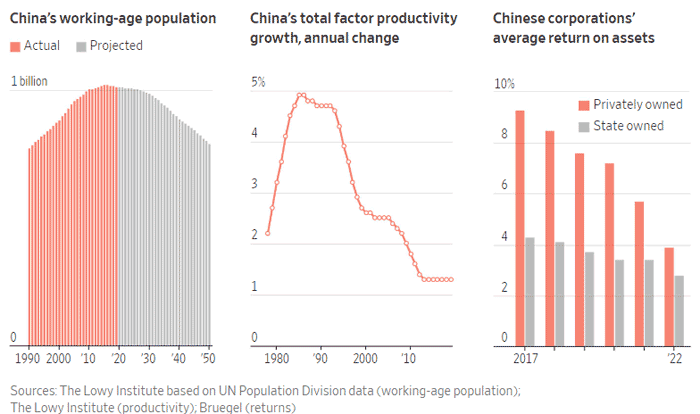I was in grad school in the 1980s with a business class led by a professor who openly admired the Japanese way of centralized economic planning.
At the time, it sure seemed to be working. Japanese companies in the electronics, automotive and some other sectors were thriving and innovating, while rich Japanese citizens were buying US real estate, to the dismay of many.
Gilmore Says.... |
 |
| Net it all out, and a few pundits are now predicting China will never surpass US GDP, or at least not for many decades. |
 |
What do you say? |
|
| Click here to send us your comments |
| |
|
|
|
It didn’t last. Starting in the early 1990s, the Japanese economy and its stock market amazingly have basically flatlined ever since.
Is the same fate headed for China?
It’s hard to imagine. For four decades, China has seen economic growth at perhaps historically unprecedented levels for such a long period of time. China devastated Western manufacturing as it took on the role of “factory to the world,” leading to non-stop plant closures across the US and Europe.
China also increasingly touted and expanded its military and economic might, launching as just one example its “Belt and Road Initiative,” in which it used infrastructure investment first to connect logistically - and strategically - with Europe but then expanding the initiative to parts of Asia, Africa and Latin America.
It looked like China was using its wealth to take over the world.
Predictions from many sources forecast China would overtake the US in GDP soon in some cases just a few years for now.
And of course, China became central to thousands of company’s supply chains. There was much talk about a “Chinese Century,” in the way the US dominated the 1900s.
But that was then, this is now.
According to an excellent article in the Wall Street Journal this week, “What worked when China was playing catch-up makes less sense now that the country is drowning in debt and running out of things to build. Parts of China are saddled with under-used bridges and airports. Millions of apartments are unoccupied. Returns on investment have sharply declined.”
The International Monetary Fund estimates China’s GDP growth will be below 4% over the next few years, less than half of its growth for most of the past four decades. Capital Economics, a London-based research firm, says China’s growth has slowed to 3% from 5% in 2019, and will fall to just 2% or so by 2030.
What is going on? First, it turns out much of China’s growth was based on a multi-decade construction boom fueled (and financed) by both federal and local governments, as well as private and state-owned business. The aggressive building of logistics infrastructure, housing, and more generated massive debt in the process. In some years housing alone accounted for more than 25% of China’s gross domestic product.
But that market is tanking, with huge numbers of unsold apartments, as many as 130 million.
Yet, as the economy slows, provinces continue to double down on construction programs, as the only elixir they can see. Case in point: the Journal reported that Yunnan province recently said it would spend millions of dollars to build a new Covid-19 quarantine facility, the size of about three football fields, despite China having ended its “zero-Covid” policy months ago, and long after the world moved on from the pandemic.
Build it and they won’t come, you might say.
Then there is China’s demographic woes. It has a rapidly aging population, and a soon to be shrinking workforce (see graphic below). Fewer workers means lower GDP. It is now commonly said of China that “It will be the first country to grow old before it became rich.”
China's Worrisome Trends

Source: Wall Steet Journal
Growing tiffs with the US politically isn’t helping China’s economy either. The movement for reshoring or at least nearshoring for the first time seems to really have some momentum, after years of mostly talk and some anecdotes here and there.
The answer to China’s economic malaise, some economists say, is for it to move to a more consumer-driven economy, as characterizes most developed economies. But China is resisting such a move, interestingly in part because more consumer spending versus savings would force government to spend a lot more on social safety nets.
Net it all out, and a few pundits are now predicting China will never surpass US GDP, or at least not for many decades.
There is another concern, and that is that with growing domestic pressure from a slowing economy, China might “do something bad,” with invading Taiwan at the top of the list. That would send supply chains and the global economy into chaos.
We may be nearing the end of the “Chinese Century” just a few decades in, transforming supply chains and going back to the future.
Any reaction to these thoughts on China? Let us know your thoughts at the Feedback button or section below.
Your Comments/Feedback
|